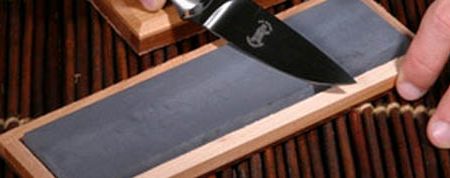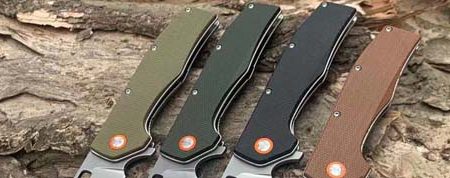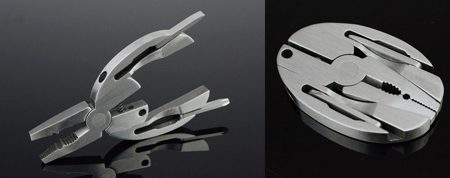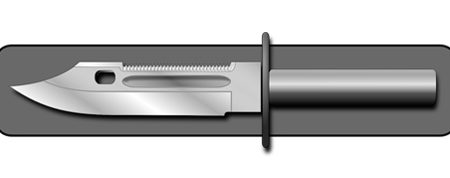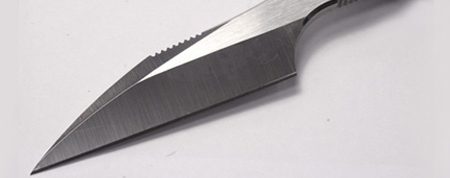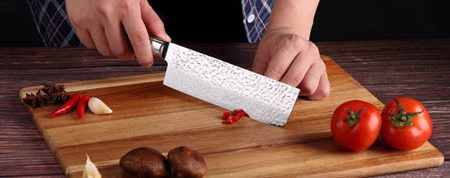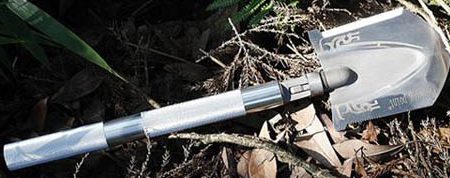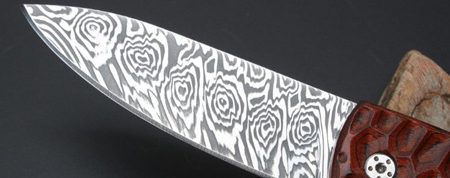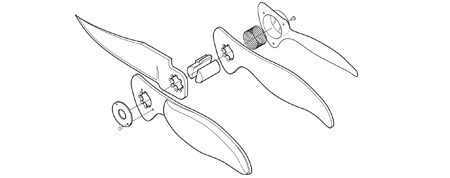Common Knife Steel Types
The most common blade steel types generally fall into the following categories:
- Tool Steel – primarily hard steel alloys used in cutting tools. Some popular steels in this group include D2, O1 and Crucible’s CPM series (i.e. CPM 3V) plus more advanced high speed steels like M4.
- Carbon Steel – generally made for rough use where toughness and durability is important. Common in survival knives and machetes. They take a sharp edge and are relatively easy to re-sharpen. The trade-off is being more prone to corrosion given the low chromium content. The most popular carbon knife steel is 1095.
- Stainless Steel – basically carbon steel with added chromium to resist corrosion and other elements which increase performance levels but usually at the expense of inferior toughness. Easily the most popular category today for EDC Folding Pocket Knives and includes the 400, 154CM, AUS, VG, CTS, MoV, Sandvik and Crucible SxxV series of steels. Note that to qualify as a true stainless steel there must be at least 13% chromium.
Ultra premium
CPM S90V
The ultimate in wear resistance and edge retention comes with CPM S90V steel. As you’d expect the carbon content is very high but the secret here is the extreme quantities of vanadium,
M390
M390 is one of the new super steels on the block, It makes knife blades requiring excellent corrosion resistance and very high hardness for excellent wear resistance. Chromium, molybdenum, vanadium, and tungsten are added to promote sharpness and edge retention. M390 hardens to 60-62 HRC.
ZDP-189
ZDP-189 by Hitachi is another of the newer super steels containing huge quantities of carbon and chromium that result in ridiculous levels of hardness. ZDP-189 averages around 64 HRC
Elmax
This is a high chromium-vanadium-molybdenum alloyed powdered steel with extremely high wear and corrosion resistance.
CTS-XHP
CTS-XHP is another relatively new knife steel that has very good edge retention and hardens to about 61 HRC.
Premium
CPM M4
CPM M4 provides superbly balances levels of abrasion resistancance and toughness through high doses of molybdenum (hence the “M”), vanadium and tungsten together with reasonably high levels of carbon. It can be hardened to around 62-64 HRC
CPM S35VN
This is using a much finer grain structure and adding small quantities of niobium they were able to improve the toughness and ability to sharpen what was already an outstanding steel in the S30V.
CPM S30V
CPM S30V (often simply referred to as S30V) steel has excellent edge retention and resists rust effortlessly.
High end
154CM
A nice hard steel similar to S30V and is reasonably resistant to corrosion. It has superb toughness good enough for most uses and holds an edge extremely well. Moderately difficult to sharpen.
ATS-34
it has very similar properties and characteristics to the 154CM, ATS-34 has great edge retention but is actually a little less rust resistant than the lower-range 440C steel.
D2
D2 steel is a tool steel often referred to as “semi-stainless” as it lacks the required amount of chromium (14%) to qualify as full stainless yet it still provides a good amount of resistance to corrosion.
VG-10
The VG-10 steel is very similar to 154CM and ATS-34 with slightly more chromium but also contains vanadium which makes it marginally “better” than these two.
H1
H1 steel from Japan’s Myodo Metals is basically the ultimate in corrosion resistance and essentially does not rust. The epitome of true stainless steel.
N680
N680 steel contains about 0.20% nitrogen and over 17% chromium making it extremely corrosion resistant.
Upper mid-range
440C
It’s reasonably tough and wear resistant but it really excels at stain resistance. The 440C blades can be easily sharpened. It has the highest levels of carbon and chromium in this group.
AUS-8
AUS-8 steel is Japanese made and like the 440C is highly resistant to rust and corrosion. It’s also similarly tough but may not hold its edge as well as some of the more premium steels which carry a greater degree of carbon. Real easy to sharpen.
CTS-BD1
A vacuum-melted stainless steel is often likened to AUS-8 and 8Cr13MoV with many putting it slightly ahead of those two based on superior edge holding. With slightly more chromium it also achieves better corrosion resistance.
8Cr13MoV
The MoV series of steels originate from China and comparable to AUS-8 but containing slightly higher carbon content.
14C28N
The 14C28N stainless steel from Swedish manufacturer Sandvik is considered an upgrade to their 13C26 described below.
Lower mid-range
420HC
420HC is similar to 420 steel but with increased levels of carbon (HC stands for High Carbon) which makes the steel harder. That results in better edge retention and resistance to corrosion. In fact, this is one of the most corrosion resistant steels out there,
440A
Very much like 420HC but with slightly more chromium which results in enhanced levels of wear resistance and edge retention but suffers from weaker anti-corrosion properties.
13C26
This is Sandvik’s version of the AEB-L steel, originally developed for razor blades. Close comparison to 440A steel with a higher carbon to chromium ratio making it generally a little harder and wearable at the expense of corrosion resistance.
Low end
420 & 420J
The 420 steel is a relatively low carbon content (usually less than 0.5%) which makes for a softer blade and as a result will tend to lose it’s edge quicker than higher end steels. Blades made from 420 steel will rapidly lose their sharp edge over a relatively short time period.
AUS-6
Japanese made equivalent to the 420 series steel. Generally low quality and relatively little carbon content.
Other Pupular Steels
In today’s fiercely competitive market the ultimate steels rarely retain their crown for long. Manufacturers consistently push the boundaries of science and technology to introduce superior alloys to the marketplace and boost profits. I remember the days when 440C was king, an impressive steel now relegated to the budget category. Sure, marketing plays a huge role today with companies using slick tactics to convince consumers that their latest steel is even better than the last. Truth is, it’s becoming increasingly difficult to evaluate these steels objectively as the incremental performance gains become indistinguishable and almost impossible to quantify outside of the laboratory. Still, here’s my take on some other steels which are popular among knife enthusiasts but still relatively rare in the marketplace.
Maxamet
Maxamet is the latest powder steel from Carpenter (aka CarTech). Its an extreme alloy with insane hardness and tremendous edge retention while still retaining a reasonable amount of toughness but at the expense of corrosion resistance (it’s not stainless). While it wasn’t designed to compete with Crucible’s chart topping CPM-S110V steel, many knife nerds like the compare the two. So, how does Maxamet compare against CPM-S110V? Well, it’s largely still up for debate but from my experience Maxamet matches S110V in edge retention but falls short on corrosion resistance. Both are ridiculously difficult to sharpen. Stay tuned as I spend more time with this steel and expand on my evaluation.
Cru-Wear
Cru-Wear is a Crucible tool steel which can be thought of as a modification of D2 steel by dialing down the carbon and chromium while jacking up the vanadium and tungsten levels. Vanadium carbides beat out chromium for hardness and and lower carbon levels make for a tougher steel. So, now it becomes comparable to CPM-3V and M4, with excellent toughness and thus resistance to chipping in knives. Bottom line is, CruWear is offered as a balance between 3V and M4. It’s tougher than M4 but won’t hold an edge as long, while being less tough than 3V but holds and edge longer. Basically a good balance of toughness and wear resistance. Currently being offered by Bark River Knives, Jake Hoback, Spyderco.

